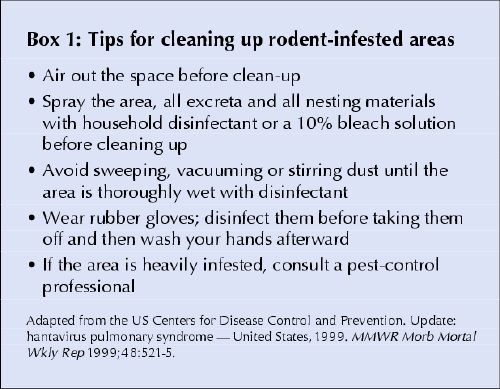Background and epidemiology: In May 2005, public health officials received laboratory confirmation from Health Canada of Quebec's first reported case of hantavirus infection, contracted by someone from Nicolet, near Trois-Rivières. In that same month Alberta reported 3 cases of hantavirus infection, including 1 fatality, within a family living in the central part of the province; a fourth, seemingly unrelated case was reported subsequently in a person from Hobbema, south of Edmonton.
Hantavirus pulmonary syndrome (HPS) is a severe rodent-borne pulmonary illness with a case- fatality rate of 40%– 50%. At least 4 species of hantavirus have been implicated as etiologic agents in North America;1 the Sin Nombre virus has been associated with the most cases. It is transmitted primarily by deermice to people who inhale aerosolized rodent excreta (urine and feces) through routine activities such as cleaning vacant cottages or rodent-infested barns. Person-to-person transmission has not been documented in North America.
Cases of HPS in Canada are extremely rare. Typically fewer than 8 are reported per year,1 with most occurring in rural settings in western provinces during the months of April, May and June. The recent, unusual number of cases in Alberta motivated provincial public health officers to seek assistance from Health Canada to investigate the cluster and prompted this article, to remind physicians about this rare but dangerous infection.
HPS was first described in 1993, in the southwestern United States. Canada's first case was recognized through active surveillance in 1994, in British Columbia; however, a retrospective review identified cases dating back to 1989. By 1999, convenience sampling of over 6000 rodents across Canada identified seropositive mice in the Yukon and in every province except Prince Edward Island and Nova Scotia, where sampling was limited. The possible occurrence in these areas of mice infected with hantavirus cannot be excluded.1
Clinical management: After an average incubation period of 14–30 days, HPS typically begins with a prodrome of headache, fever and myalgia, soon followed by pulmonary edema, which often leads to severe respiratory compromise. Thrombocytopenia, the presence of immunoblasts and hemoconcentration are characteristic findings. Laboratory criteria for diagnosis include positive test results for any of the following: hantavirus-specific IgM, an increase of 4- fold or greater in IgG antibody titres, amplification of viral RNA by reverse transcription and polymerase chain reaction, or hantavirus antigen in tissue (an immunohistochemical test).
Other than supportive care, no treatment exists for hantavirus infection. The probability of survival increases with early recognition, hospital admission and aggressive pulmonary and hemodynamic support.2
Prevention: Although the risk of HPS is very low for most Canadians, the consequences of infection are so great that taking preventive measures still remains prudent. These include cleaning up any areas likely to become infested with rodents (see Box 1), eliminating rodent harbourage (e.g., by patching cracks, filling crevices and sealing other small openings into structures where rodents might find food and shelter), reducing local rodent populations and avoiding rodents when outdoors.
Box 1.

The likelihood of HPS increases among workers frequently exposed to rodents, such as pest-control workers, some farm workers, and building and fire inspectors. Precautions for professional workers cleaning buildings with heavy rodent infestation include wearing appropriate gloves, goggles and respiratory protective devices, as outlined in the CDC recommendations.2 Negative-pressure respirators may also be considered for home use, but are contraindicated in persons with underlying respiratory or cardiac conditions. Homeowners with a heavily infested building are advised to consult a pest-control professional.
Erica Weir CMAJ
References
- 1.Drebot MA, Artsob H, Werker D. Hantavirus pulmonary syndrome in Canada, 1989–1999. Can Commun Dis Rep 2000;26(8):65-9. Available: www.phac-aspc.gc.ca/publicat/ccdr-rmtc/00vol26/dr2608ea.html (accessed 2005 June 10). [PubMed]
- 2.Mills JN, Corneli A, Young JC, Garrison LE, Khan AS, Ksiazek TG. Hantavirus pulmonary syndrome — United States: updated recommendations for risk reduction. Centers for Disease Control and Prevention. MMWR Recomm Rep 2002;51(RR- 9):1-12. [PubMed]


